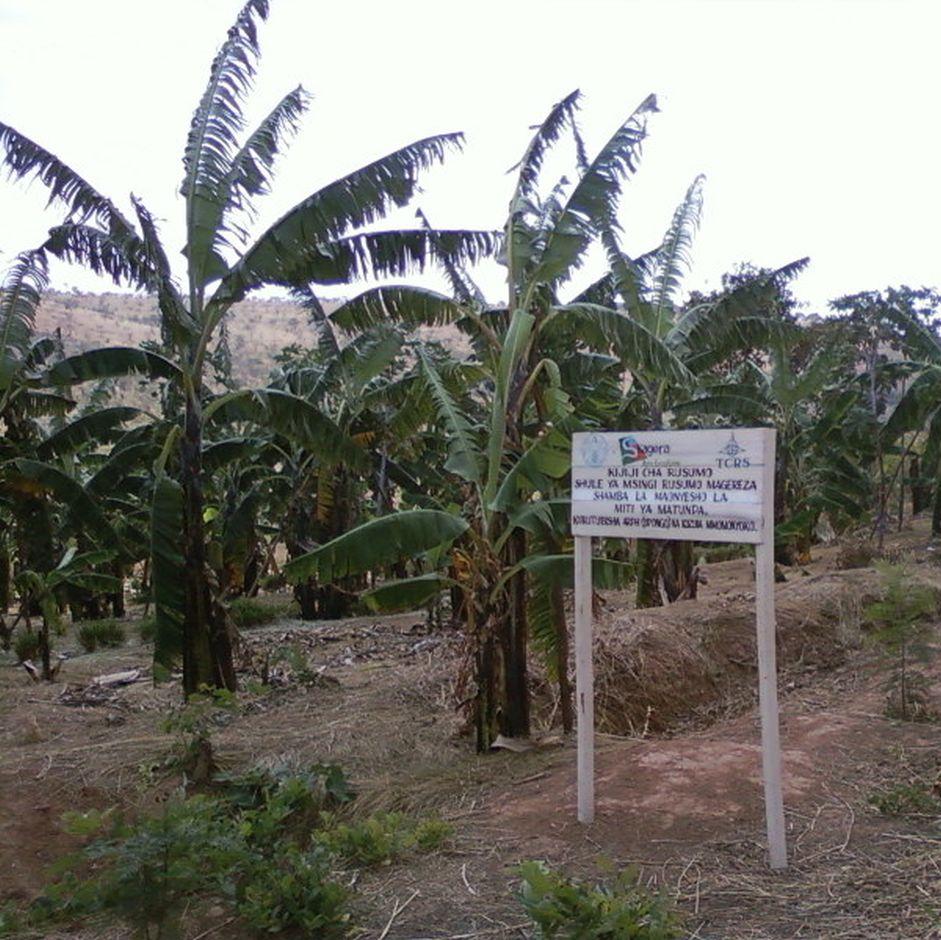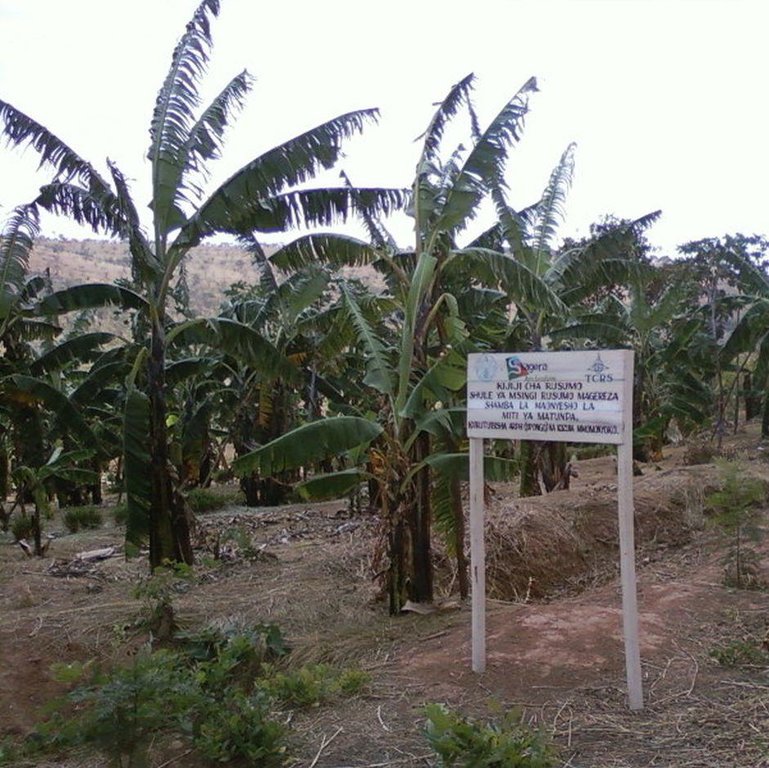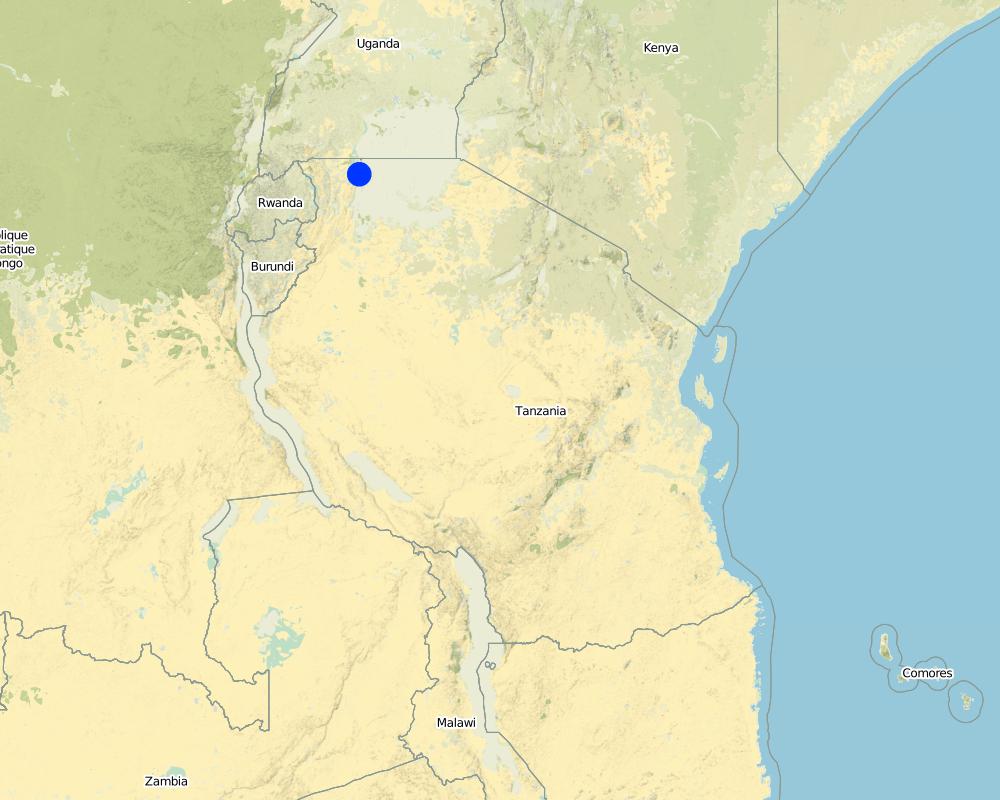Slope cross barier in banana combined with common agronomical measures production [坦桑尼亚联合共和国]
- 创建:
- 更新:
- 编制者: Godfrey Baraba
- 编辑者: –
- 审查者: David Streiff, Alexandra Gavilano
Makinganga maji mchanganyiko
technologies_1216 - 坦桑尼亚联合共和国
查看章节
全部展开 全部收起1. 一般信息
1.2 参与该技术评估和文件编制的资源人员和机构的联系方式
SLM专业人员:
Kakilla Samuel
TCRS-Ngara
坦桑尼亚联合共和国
SLM专业人员:
Chitege Daudi
Magereza Rusoma Primary School
坦桑尼亚联合共和国
SLM专业人员:
Masikundima Iddi
Ngara District Council
坦桑尼亚联合共和国
SLM专业人员:
有助于对技术进行记录/评估的项目名称(如相关)
The Transboundary Agro-ecosystem Management Project for the Kagera River Basin (GEF-FAO / Kagera TAMP )有助于对技术进行记录/评估的机构名称(如相关)
Bukoba district council (Bukoba district council) - 坦桑尼亚联合共和国有助于对技术进行记录/评估的机构名称(如相关)
Ngara District Council (Ngara District Council) - 坦桑尼亚联合共和国有助于对技术进行记录/评估的机构名称(如相关)
Missenyi District Council (Missenyi District Council) - 坦桑尼亚联合共和国1.3 关于使用通过WOCAT记录的数据的条件
编制者和关键资源人员接受有关使用通过WOCAT记录数据的条件。:
是
1.4 所述技术的可持续性声明
这里所描述的技术在土地退化方面是否存在问题,导致无法被认为是一种可持续的土地管理技术?:
否
2. SLM技术的说明
2.1 技术简介
技术定义:
Is the embanked soils on the lower side of the furrow, lemon grass and vetiver grass strips along the contour lines combined with Farm yard manures and grass mulch application in banana production.
2.2 技术的详细说明
说明:
The slope cross barrier technology in banana production is a 2m deep by 0.6 wide furrow at the less slope combined with lemon grass, vetiver grass contour strips at the greater slopes.. The lemon grasses and vertiver grass are planted in single row spaced 0.3m plant to plant. The distance between strips is about 18m at the slope category of 2%. The technology is applied on the cropland in the tropics, sub humid, dissected plain to flood plains, sandy clay loam over sand clay and deep to moderate deep soils. The land is cultivated manually using hand hoes in a mixed production system. The land ownership is communal and individual not titled. The establishment procedures includes planting of banana suckers, lemon grass, vetiver grass, fruit trees, construction of fanya chini and planting gravelia spps along the boundaries. The maintenance procedures require application of FYM at the rate of 24-36kg per plant. Grass mulch is spread across the slope at the thickness of 0.15m. The average establishment costs is US$ 3,531.42 per hectare while maintenance costs on average is US$ 351.77 per hectare. The technology was introduced fifteen months past ( March 2013) using Demonstration plots methodology. Common agronomic measures such as using improved banana suckers and banana weevils trapping can add extra effectiveness to the main technology.
Purpose of the Technology: The general purpose of the technology is to reduce soil erosion, reduce soil moisture stress and increase soil nutrient cycling and soil organic matters.
Establishment / maintenance activities and inputs: The establishment activities includes first, clearing and cultivation of land in May done manually using machete and hand hoes. Second, harrowing in May done manually using fork handhoes. Third is identification and demarcation of contour lines doneusing A-frame. Fourth is spacing and digging of holes for banana and fruit trees done manually done. Fifth is planting of banana suckers and fruit trees done manually. Sixth is planting of vertiver and lemon grasses along the demarcated contour lines done manually, seventh is digging the farrow and excavating soils to be placed at the lower side of the furrow done manually. The maintenance activities include; first, weeding the entire field using hands done in twice April and October. Second is manure application using plastic buskets done. Third is spreading grass mulch done manually, fourth is desuckering using chisel hand hoes done twice in April and October. Fourth is detrushing using machete and local made tools (rwabyo) done twice (May and January). Last but not least is harvesting of banana, lemon grass and fruits done on market demand.
Natural / human environment: The land ownership is communal and individual not entitled while the water use right is open access. The natural environments are 1184mm of rainfall.The technology is tolerant to drought and seasonal rainfall decrease. Soil fertility is low to moderate. Top soil organic matter is medium, Soil drainage is medium. Soil water storage capacity is medium.
2.3 技术照片
2.5 已应用该技术的、本评估所涵盖的国家/地区/地点
国家:
坦桑尼亚联合共和国
区域/州/省:
Tanzania
有关地点的进一步说明:
Bukoba
具体说明该技术的分布:
- 均匀地分布在一个区域
如果不知道精确的区域,请注明大致覆盖的区域:
- < 0.1 平方千米(10 公顷)
注释:
A demonstration plot for pupils self-reliance education studies established a plot measured 2 acres where the technology is applied.
Map
×2.6 实施日期
如果不知道确切的年份,请说明大概的日期:
- 不到10年前(最近)
2.7 技术介绍
详细说明该技术是如何引入的:
- 通过项目/外部干预
注释(项目类型等):
In February 2013 TAMP -Kagera, Tanzania introduced the technology through demonstration sites for cross slope beerier technology at Magereza Rusumo Primary School.
3. SLM技术的分类
3.1 该技术的主要目的
- 减少、预防、恢复土地退化
3.2 应用该技术的当前土地利用类型

农田
- 一年一作
- 多年一作(非木材)
- 乔木与灌木的种植
年作 - 具体指明作物:
- 谷物类 - 玉米
- 谷类 - 高粱
- lemon grass, vertiver grass
多年生(非木质)作物 - 指定作物:
- 香蕉/芭蕉/蕉麻
乔木和灌木种植 - 指定作物:
- 鳄梨
- 芒果、山竹果、番石榴
- fruit trees, oranges, Pawpaw
每年的生长季节数:
- 2
具体说明:
Longest growing period in days: 90; Longest growing period from month to month: March to May; Second longest growing period in days: 60;Second longest growing period from month to month: November to December
注释:
Major land use problems (compiler’s opinion): The major land use problems were soil erosion, moistture stress, declining soil nutrients and organic matters.
Major land use problems (land users’ perception): The major land use problems were reduced soil fertility.
Future (final) land use (after implementation of SLM Technology): Cropland: Cp: Perennial (non-woody) cropping
3.4 供水
该技术所应用土地的供水:
- 雨养
3.5 该技术所属的SLM组
- 改良的地面/植被覆盖
- 横坡措施
3.6 包含该技术的可持续土地管理措施

农艺措施
- A1:植被和土壤覆盖层
- A2:有机质/土壤肥力
- A6:残株管理

植物措施
- V2:草和多年生草本植物

结构措施
- S2:堤、岸
- S4:平沟、坑
注释:
Type of agronomic measures: mulching, temporary trashlines, manure / compost / residues, pits
Type of vegetative measures: aligned: -contour, aligned: -along boundary, aligned: -linear, scattered / dispersed, in blocks
3.7 该技术强调的主要土地退化类型

土壤水蚀
- Wt:表土流失/地表侵蚀

化学性土壤退化
- Cn:肥力下降和有机质含量下降(非侵蚀所致)

生物性退化
- Bl:土壤寿命损失
注释:
Main causes of degradation: soil management (Cultivation along the slope), change of seasonal rainfall (decreased rainfall intensity.), droughts (Increased length of dry spell.), population pressure (Increased population density had forced to cultivate slope land to meet the social economical requirements.), poverty / wealth (Land users cant afford to invest in land concervations.), education, access to knowledge and support services (Inadequate staffing limits effective support services for land users to access land concervation knowledge.), governance / institutional (Environment policy implimentation is weak at lower levels.)
3.8 防止、减少或恢复土地退化
具体数量名该技术与土地退化有关的目标:
- 防止土地退化
- 减少土地退化
4. 技术规范、实施活动、投入和成本
4.1 该技术的技术图纸
技术规范(与技术图纸相关):
Technical knowledge required for field staff / advisors: low (Basic priciples are taught at colleges.)
Technical knowledge required for land users: moderate (The new technology should be taught first for a better innovation and adoption processes.)
Main technical functions: control of raindrop splash, control of dispersed runoff: retain / trap, control of dispersed runoff: impede / retard, increase in organic matter, increase of infiltration, increase / maintain water stored in soil, increase of biomass (quantity)
Secondary technical functions: stabilisation of soil (eg by tree roots against land slides), increase in nutrient availability (supply, recycling,…), reduction in wind speed
Mulching
Material/ species: Panic grasses
Quantity/ density: 1500
Remarks: 0.15m thickness across the slope.
Temporary trashlines
Material/ species: banana dry leaves abd old pseudostems.
Manure / compost / residues
Material/ species: Trushlines
Quantity/ density: 7.5t0nes
Remarks: A 2m X2mX3m pit is dug at the centre of foor banana stools and pilled.
Pits
Material/ species: .
Remarks: a 0.3m depth is left un covered with soil below the soil surface level
Aligned: -contour
Vegetative material: G : grass
Number of plants per (ha): 700
Width within rows / strips / blocks (m): 0.6
Aligned: -along boundary
Vegetative material: T : trees / shrubs
Number of plants per (ha): 70
Width within rows / strips / blocks (m): 6
Aligned: -linear
Vegetative material: C : perennial crops
Number of plants per (ha): 715
Spacing between rows / strips / blocks (m): 4
Width within rows / strips / blocks (m): 3.5
Scattered / dispersed
Vegetative material: T : trees / shrubs
Number of plants per (ha): 625
Spacing between rows / strips / blocks (m): 4
Width within rows / strips / blocks (m): 4
In blocks
Vegetative material: F : fruit trees / shrubs
Width within rows / strips / blocks (m): 3
Trees/ shrubs species: gravelia spps
Fruit trees / shrubs species: Mango, Pawpaw and oranges
Perennial crops species: Banana
Grass species: lemon grass and vetiver
Retention/infiltration ditch/pit, sediment/sand trap
Depth of ditches/pits/dams (m): 0.2
Width of ditches/pits/dams (m): 0.2
Length of ditches/pits/dams (m): 0.2
Structural measure: Fanya chini
Vertical interval between structures (m): E
Depth of ditches/pits/dams (m): 1.5
Width of ditches/pits/dams (m): 0.6
Length of ditches/pits/dams (m): 105
Height of bunds/banks/others (m): 0.6
Width of bunds/banks/others (m): 0.9
Length of bunds/banks/others (m): 105
4.2 有关投入和成本计算的一般信息
具体说明成本计算所用货币:
- 美元
注明雇用劳工的每日平均工资成本:
1.88
4.3 技术建立活动
| 活动 | 时间(季度) | |
|---|---|---|
| 1. | Ploughoing | May |
| 2. | Harrowing | may |
| 3. | Digging holes | |
| 4. | Demarcating contour lines | |
| 5. | Digging holes for planting banana suckers | |
| 6. | Demacarting banana spacings. | |
| 7. | Mixing FYM | |
| 8. | Plating banana suckers | |
| 9. | Planting vetiver grass and lemon grass. | May |
| 10. | Planting mango, pawpaw, orange and gravelia | January |
| 11. | Demarcation of contour line using F-frame. | March |
| 12. | Digging the furrow and excavating soils. | May |
4.4 技术建立所需要的费用和投入
| 对投入进行具体说明 | 单位 | 数量 | 单位成本 | 每项投入的总成本 | 土地使用者承担的成本% | |
|---|---|---|---|---|---|---|
| 劳动力 | Labour | ha | 1.0 | 541.18 | 541.18 | |
| 设备 | Tools | ha | 1.0 | 134.31 | 134.31 | |
| 植物材料 | Seedling | ha | 1.0 | 2032.4 | 2032.4 | |
| 肥料和杀菌剂 | Compost / manure | ha | 1.0 | 823.53 | 823.53 | |
| 技术建立所需总成本 | 3531.42 | |||||
| 技术建立总成本,美元 | 3531.42 | |||||
注释:
Duration of establishment phase: 15 month(s)
4.5 维护/经常性活动
| 活动 | 时间/频率 | |
|---|---|---|
| 1. | Weeding | april |
| 2. | Desuckering and detrushing | January and may |
| 3. | Mulch grass application | May |
| 4. | Pr-oping (anchor poles placement) | routeenly |
| 5. | Harvesting banana fruits. | routeenly |
| 6. | Planting ricinus communis | February |
| 7. | Trees Pruning | |
| 8. | Harvesting fruits | |
| 9. | To remove soil sediments from the furrow and place the in the space between. | May and January |
| 10. | To cvlear fire-break along the bounderies | May |
4.6 维护/经常性活动所需要的费用和投入(每年)
| 对投入进行具体说明 | 单位 | 数量 | 单位成本 | 每项投入的总成本 | 土地使用者承担的成本% | |
|---|---|---|---|---|---|---|
| 劳动力 | Labour | ha | 1.0 | 153.73 | 153.73 | 100.0 |
| 植物材料 | Seeds | ha | 1.0 | 1.96 | 1.96 | 100.0 |
| 肥料和杀菌剂 | Grass mulch | ha | 1.0 | 196.08 | 196.08 | 100.0 |
| 技术维护所需总成本 | 351.77 | |||||
| 技术维护总成本,美元 | 351.77 | |||||
5. 自然和人文环境
5.1 气候
年降雨量
- < 250毫米
- 251-500毫米
- 501-750毫米
- 751-1,000毫米
- 1,001-1,500毫米
- 1,501-2,000毫米
- 2,001-3,000毫米
- 3,001-4,000毫米
- > 4,000毫米
有关降雨的规范/注释:
Highet precipitation March to May and second precipitation November to December.
农业气候带
- 半湿润
Thermal climate class: tropics. All months is above 18°C
LGP 60dys to 90dys
5.2 地形
平均坡度:
- 水平(0-2%)
- 缓降(3-5%)
- 平缓(6-10%)
- 滚坡(11-15%)
- 崎岖(16-30%)
- 陡峭(31-60%)
- 非常陡峭(>60%)
地形:
- 高原/平原
- 山脊
- 山坡
- 山地斜坡
- 麓坡
- 谷底
垂直分布带:
- 0-100 m a.s.l.
- 101-500 m a.s.l.
- 501-1,000 m a.s.l.
- 1,001-1,500 m a.s.l.
- 1,501-2,000 m a.s.l.
- 2,001-2,500 m a.s.l.
- 2,501-3,000 m a.s.l.
- 3,001-4,000 m a.s.l.
- > 4,000 m a.s.l.
说明该技术是否专门应用于:
- 不相关
关于地形的注释和进一步规范:
Slopes on average: 3 adption land users are found in the flat areas and a 1.5 acre is demonstration plot site where thye adoption plots found elsewhere.
5.3 土壤
平均土层深度:
- 非常浅(0-20厘米)
- 浅(21-50厘米)
- 中等深度(51-80厘米)
- 深(81-120厘米)
- 非常深(> 120厘米)
土壤质地(表土):
- 中粒(壤土、粉土)
表土有机质:
- 中(1-3%)
如有可能,附上完整的土壤描述或具体说明可用的信息,例如土壤类型、土壤酸碱度、阳离子交换能力、氮、盐度等。:
Soil depth on average: Redish brown/dark brown sandy clay loam over sandy clay
Soil fertilityis low and DP Low to moderate
Soil drainage / infiltration is medium and DP well drained
Soil water storage capacity is medium
5.4 水资源可用性和质量
地下水位表:
> 50米
地表水的可用性:
中等
水质(未处理):
不良饮用水(需要处理)
关于水质和水量的注释和进一步规范:
Availability of surface water: Bordering Kagera river.
5.5 生物多样性
物种多样性:
- 中等
关于生物多样性的注释和进一步规范:
Earthworms, black ants etc.
5.6 应用该技术的土地使用者的特征
生产系统的市场定位:
- 混合(生计/商业)
- 商业/市场
个人或集体:
- 团体/社区
机械化水平:
- 手工作业
性别:
- 女人
- 男人
说明土地使用者的其他有关特征:
Land users applying the Technology are mainly common / average land users
Market orientation of production system: Fruits intededed for sale and banana are dual purposes.
Level of mechanization: Hand hoes are used.
5.7 应用该技术的土地使用者使用的平均土地面积
- < 0.5 公顷
- 0.5-1 公顷
- 1-2 公顷
- 2-5公顷
- 5-15公顷
- 15-50公顷
- 50-100公顷
- 100-500公顷
- 500-1,000公顷
- 1,000-10,000公顷
- > 10,000公顷
这被认为是小规模、中规模还是大规模的(参照当地实际情况)?:
- 小规模的
5.8 土地所有权、土地使用权和水使用权
土地所有权:
- 个人,未命名
- Institutions
土地使用权:
- 个人
- village goverment
用水权:
- 自由进入(无组织)
- village goverment
5.9 进入服务和基础设施的通道
健康:
- 贫瘠
- 适度的
- 好
教育:
- 贫瘠
- 适度的
- 好
技术援助:
- 贫瘠
- 适度的
- 好
就业(例如非农):
- 贫瘠
- 适度的
- 好
市场:
- 贫瘠
- 适度的
- 好
能源:
- 贫瘠
- 适度的
- 好
道路和交通:
- 贫瘠
- 适度的
- 好
金融服务:
- 贫瘠
- 适度的
- 好
6. 影响和结论性说明
6.1 该技术的现场影响
社会经济效应
生产
作物生产
SLM之前的数量:
0
SLM之后的数量:
5
注释/具体说明:
Banana first harvest
生产故障风险
注释/具体说明:
Mulch reduced moisture stress
收入和成本
农业投入费用
注释/具体说明:
Improved seeds and seedlings, FYM & grass mulch
农业收入
收入来源的多样性
注释/具体说明:
Orchad as comlimentary enterprises
工作量
注释/具体说明:
FYM and mulch applications demanded extra labour
社会文化影响
食品安全/自给自足
注释/具体说明:
Conseved land ensured soil improvement to ensure food availability, accessility and utilizations
SLM/土地退化知识
注释/具体说明:
AESA conducted during FFS
社会经济弱势群体的情况
注释/具体说明:
Equal chances for different gender considered in FFS formulation
livelihood and human well-being
注释/具体说明:
The effective technology duration is too short to obeserve impacts, but we can say that, there is hope for the technology to contribute highly on livelihod and human wellbeing
生态影响
水循环/径流
地表径流
注释/具体说明:
Mulching
蒸发
注释/具体说明:
Mulching
土壤
土壤水分
注释/具体说明:
Pitt and furrows
土壤覆盖层
注释/具体说明:
Mulching
土壤流失
注释/具体说明:
Contours
土壤有机物/地下C
注释/具体说明:
FYM
生物多样性:植被、动物
生物量/地上C
注释/具体说明:
Trushlines
6.2 该技术的场外影响已经显现
对邻近农田的破坏
注释/具体说明:
Ditches traped running water down the slope
对公共/私人基础设施的破坏
注释/具体说明:
Farrow and bunds along contour lines minimized water run off in the area
6.3 技术对渐变气候以及与气候相关的极端情况/灾害的暴露和敏感性(土地使用者认为的极端情况/灾害)
气候有关的极端情况(灾害)
气象灾害
| 该技术是如何应对的? | |
|---|---|
| 局地暴雨 | 不好 |
气候灾害
| 该技术是如何应对的? | |
|---|---|
| 干旱 | 好 |
注释:
The technology can be modified to become more tolerant by meter drain construction from the contour furrow into drainage ditches to collect excess water during heavy rainfall events. This excess water should be used for small scale irrigation.
6.4 成本效益分析
技术收益与技术建立成本相比如何(从土地使用者的角度看)?
短期回报:
消极
长期回报:
非常积极
技术收益与技术维护成本/经常性成本相比如何(从土地使用者的角度看)?
短期回报:
稍微积极
长期回报:
中性/平衡
6.5 技术采用
- > 50%
如若可行,进行量化(住户数量和/或覆盖面积):
8 households
在所有采用这项技术的人当中,有多少人是自发的,即未获得任何物质奖励/付款?:
- 11-50%
注释:
4 land user families have adopted the Technology with external material support
Comments on acceptance with external material support: Only the primary school received external materials to establish a 1.5 acre demonstration plots.
4 land user families have adopted the Technology without any external material support
Comments on spontaneous adoption: Three teachers applied the technology at their own lands bearing their full cost of implimentation.
There is a strong trend towards spontaneous adoption of the Technology
Comments on adoption trend: A 75% adption rate within a less than two years effective duration implies a strong adoption trend.
6.7 该技术的优点/长处/机会
| 编制者或其他关键资源人员认为的长处/优势/机会 |
|---|
| Easy to learn and practice. |
| social economic and production very feasible at increasing return to scale. |
| Ecological benefits should maintain constant returns to scale |
6.8 技术的弱点/缺点/风险及其克服方法
| 编制者或其他关键资源人员认为的弱点/缺点/风险 | 如何克服它们? |
|---|---|
| Increased farm input costs. | |
| Highly extension services demand to learn new technology. | |
| Thieving attractions |
7. 参考和链接
7.1 信息的方法/来源
- 实地考察、实地调查
- 与土地使用者的访谈
(现场)数据是什么时候汇编的?:
07/08/2014
链接和模块
全部展开 全部收起链接
无链接
模块
无模块




